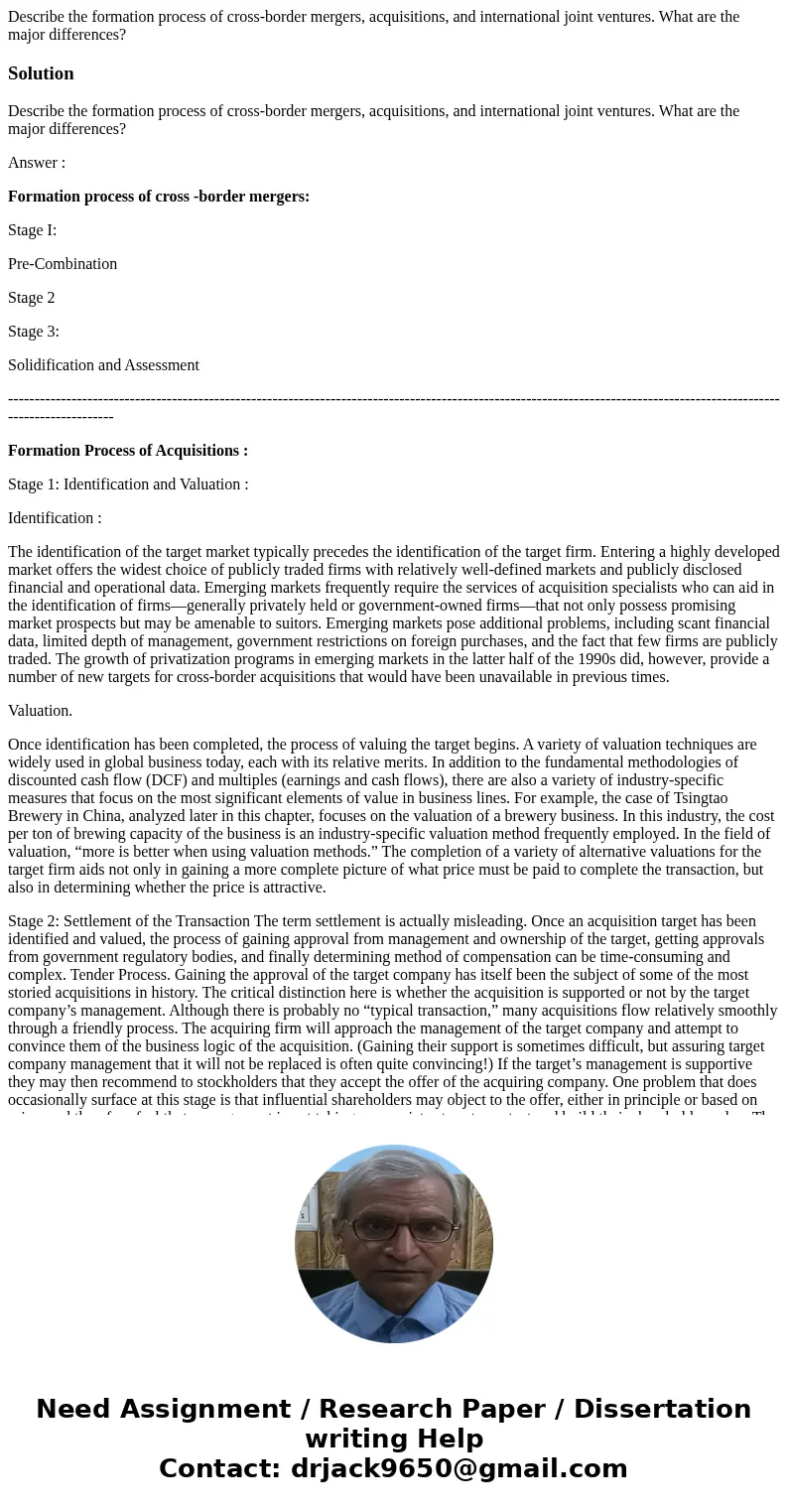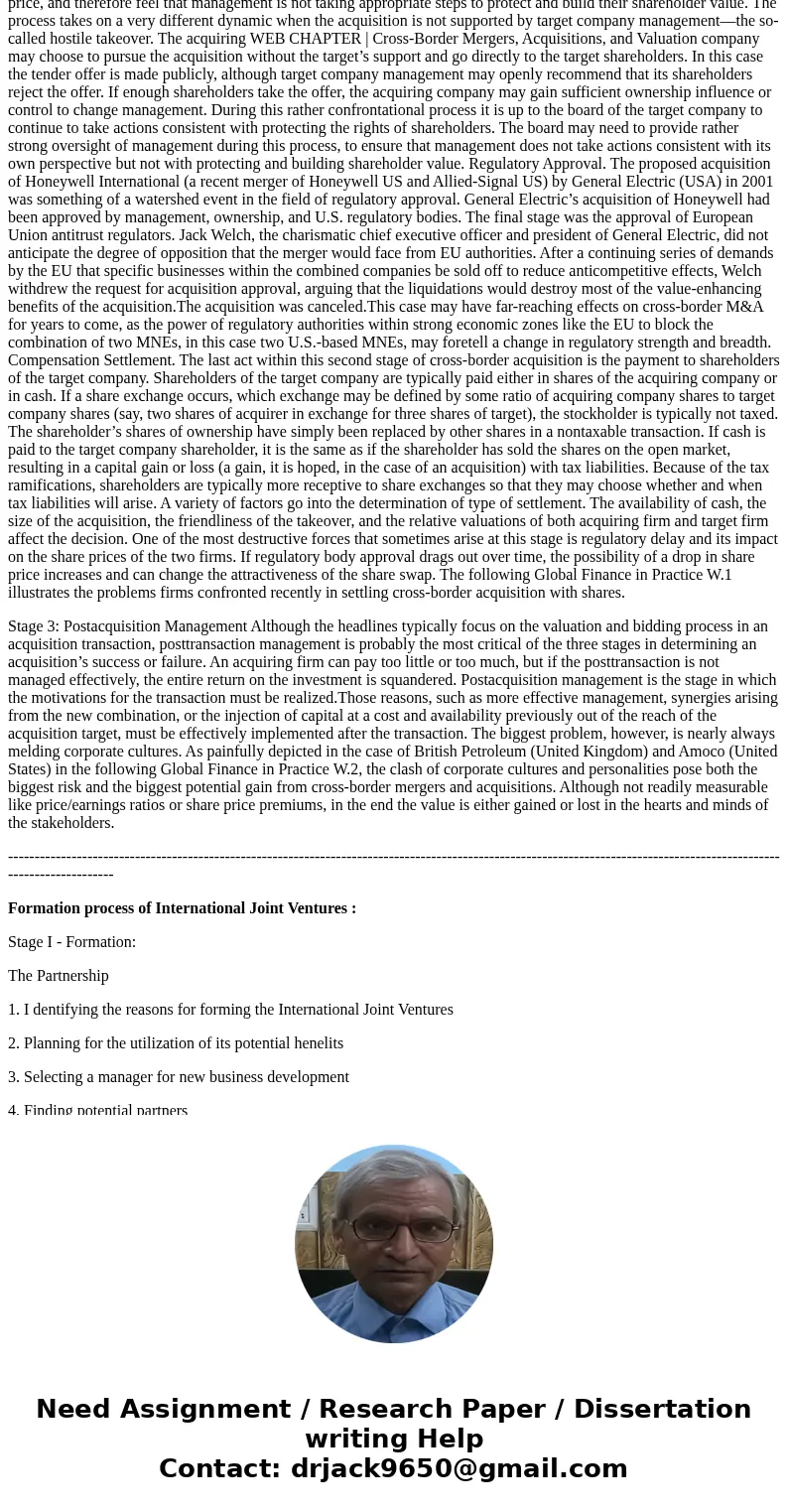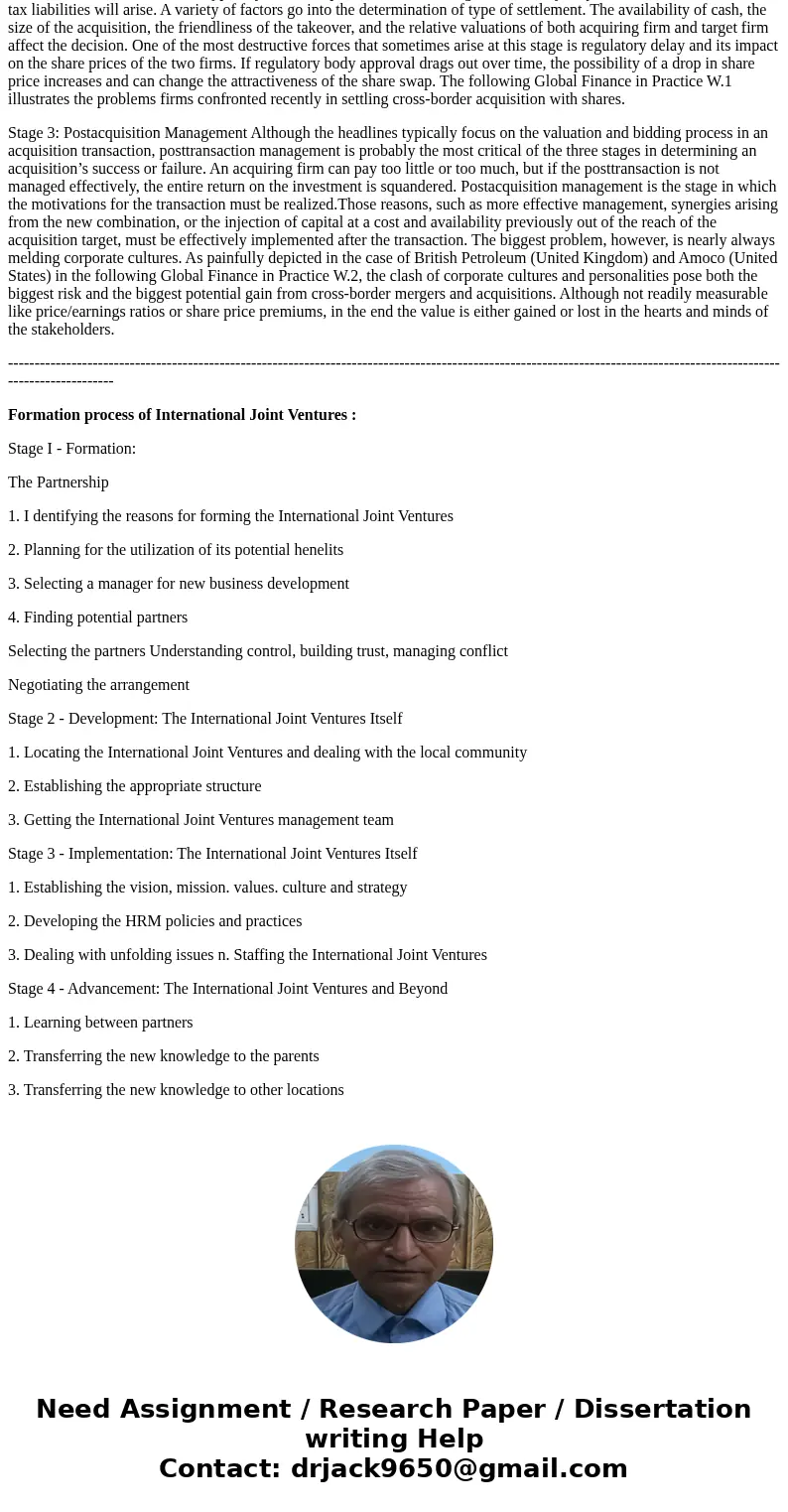Describe the formation process of crossborder mergers acquis
Describe the formation process of cross-border mergers, acquisitions, and international joint ventures. What are the major differences?
Solution
Describe the formation process of cross-border mergers, acquisitions, and international joint ventures. What are the major differences?
Answer :
Formation process of cross -border mergers:
Stage I:
Pre-Combination
Stage 2
Stage 3:
Solidification and Assessment
----------------------------------------------------------------------------------------------------------------------------------------------------------------------
Formation Process of Acquisitions :
Stage 1: Identification and Valuation :
Identification :
The identification of the target market typically precedes the identification of the target firm. Entering a highly developed market offers the widest choice of publicly traded firms with relatively well-defined markets and publicly disclosed financial and operational data. Emerging markets frequently require the services of acquisition specialists who can aid in the identification of firms—generally privately held or government-owned firms—that not only possess promising market prospects but may be amenable to suitors. Emerging markets pose additional problems, including scant financial data, limited depth of management, government restrictions on foreign purchases, and the fact that few firms are publicly traded. The growth of privatization programs in emerging markets in the latter half of the 1990s did, however, provide a number of new targets for cross-border acquisitions that would have been unavailable in previous times.
Valuation.
Once identification has been completed, the process of valuing the target begins. A variety of valuation techniques are widely used in global business today, each with its relative merits. In addition to the fundamental methodologies of discounted cash flow (DCF) and multiples (earnings and cash flows), there are also a variety of industry-specific measures that focus on the most significant elements of value in business lines. For example, the case of Tsingtao Brewery in China, analyzed later in this chapter, focuses on the valuation of a brewery business. In this industry, the cost per ton of brewing capacity of the business is an industry-specific valuation method frequently employed. In the field of valuation, “more is better when using valuation methods.” The completion of a variety of alternative valuations for the target firm aids not only in gaining a more complete picture of what price must be paid to complete the transaction, but also in determining whether the price is attractive.
Stage 2: Settlement of the Transaction The term settlement is actually misleading. Once an acquisition target has been identified and valued, the process of gaining approval from management and ownership of the target, getting approvals from government regulatory bodies, and finally determining method of compensation can be time-consuming and complex. Tender Process. Gaining the approval of the target company has itself been the subject of some of the most storied acquisitions in history. The critical distinction here is whether the acquisition is supported or not by the target company’s management. Although there is probably no “typical transaction,” many acquisitions flow relatively smoothly through a friendly process. The acquiring firm will approach the management of the target company and attempt to convince them of the business logic of the acquisition. (Gaining their support is sometimes difficult, but assuring target company management that it will not be replaced is often quite convincing!) If the target’s management is supportive they may then recommend to stockholders that they accept the offer of the acquiring company. One problem that does occasionally surface at this stage is that influential shareholders may object to the offer, either in principle or based on price, and therefore feel that management is not taking appropriate steps to protect and build their shareholder value. The process takes on a very different dynamic when the acquisition is not supported by target company management—the so-called hostile takeover. The acquiring WEB CHAPTER | Cross-Border Mergers, Acquisitions, and Valuation company may choose to pursue the acquisition without the target’s support and go directly to the target shareholders. In this case the tender offer is made publicly, although target company management may openly recommend that its shareholders reject the offer. If enough shareholders take the offer, the acquiring company may gain sufficient ownership influence or control to change management. During this rather confrontational process it is up to the board of the target company to continue to take actions consistent with protecting the rights of shareholders. The board may need to provide rather strong oversight of management during this process, to ensure that management does not take actions consistent with its own perspective but not with protecting and building shareholder value. Regulatory Approval. The proposed acquisition of Honeywell International (a recent merger of Honeywell US and Allied-Signal US) by General Electric (USA) in 2001 was something of a watershed event in the field of regulatory approval. General Electric’s acquisition of Honeywell had been approved by management, ownership, and U.S. regulatory bodies. The final stage was the approval of European Union antitrust regulators. Jack Welch, the charismatic chief executive officer and president of General Electric, did not anticipate the degree of opposition that the merger would face from EU authorities. After a continuing series of demands by the EU that specific businesses within the combined companies be sold off to reduce anticompetitive effects, Welch withdrew the request for acquisition approval, arguing that the liquidations would destroy most of the value-enhancing benefits of the acquisition.The acquisition was canceled.This case may have far-reaching effects on cross-border M&A for years to come, as the power of regulatory authorities within strong economic zones like the EU to block the combination of two MNEs, in this case two U.S.-based MNEs, may foretell a change in regulatory strength and breadth. Compensation Settlement. The last act within this second stage of cross-border acquisition is the payment to shareholders of the target company. Shareholders of the target company are typically paid either in shares of the acquiring company or in cash. If a share exchange occurs, which exchange may be defined by some ratio of acquiring company shares to target company shares (say, two shares of acquirer in exchange for three shares of target), the stockholder is typically not taxed. The shareholder’s shares of ownership have simply been replaced by other shares in a nontaxable transaction. If cash is paid to the target company shareholder, it is the same as if the shareholder has sold the shares on the open market, resulting in a capital gain or loss (a gain, it is hoped, in the case of an acquisition) with tax liabilities. Because of the tax ramifications, shareholders are typically more receptive to share exchanges so that they may choose whether and when tax liabilities will arise. A variety of factors go into the determination of type of settlement. The availability of cash, the size of the acquisition, the friendliness of the takeover, and the relative valuations of both acquiring firm and target firm affect the decision. One of the most destructive forces that sometimes arise at this stage is regulatory delay and its impact on the share prices of the two firms. If regulatory body approval drags out over time, the possibility of a drop in share price increases and can change the attractiveness of the share swap. The following Global Finance in Practice W.1 illustrates the problems firms confronted recently in settling cross-border acquisition with shares.
Stage 3: Postacquisition Management Although the headlines typically focus on the valuation and bidding process in an acquisition transaction, posttransaction management is probably the most critical of the three stages in determining an acquisition’s success or failure. An acquiring firm can pay too little or too much, but if the posttransaction is not managed effectively, the entire return on the investment is squandered. Postacquisition management is the stage in which the motivations for the transaction must be realized.Those reasons, such as more effective management, synergies arising from the new combination, or the injection of capital at a cost and availability previously out of the reach of the acquisition target, must be effectively implemented after the transaction. The biggest problem, however, is nearly always melding corporate cultures. As painfully depicted in the case of British Petroleum (United Kingdom) and Amoco (United States) in the following Global Finance in Practice W.2, the clash of corporate cultures and personalities pose both the biggest risk and the biggest potential gain from cross-border mergers and acquisitions. Although not readily measurable like price/earnings ratios or share price premiums, in the end the value is either gained or lost in the hearts and minds of the stakeholders.
----------------------------------------------------------------------------------------------------------------------------------------------------------------------
Formation process of International Joint Ventures :
Stage I - Formation:
The Partnership
1. I dentifying the reasons for forming the International Joint Ventures
2. Planning for the utilization of its potential henelits
3. Selecting a manager for new business development
4. Finding potential partners
Selecting the partners Understanding control, building trust, managing conflict
Negotiating the arrangement
Stage 2 - Development: The International Joint Ventures Itself
1. Locating the International Joint Ventures and dealing with the local community
2. Establishing the appropriate structure
3. Getting the International Joint Ventures management team
Stage 3 - Implementation: The International Joint Ventures Itself
1. Establishing the vision, mission. values. culture and strategy
2. Developing the HRM policies and practices
3. Dealing with unfolding issues n. Staffing the International Joint Ventures
Stage 4 - Advancement: The International Joint Ventures and Beyond
1. Learning between partners
2. Transferring the new knowledge to the parents
3. Transferring the new knowledge to other locations



 Homework Sourse
Homework Sourse